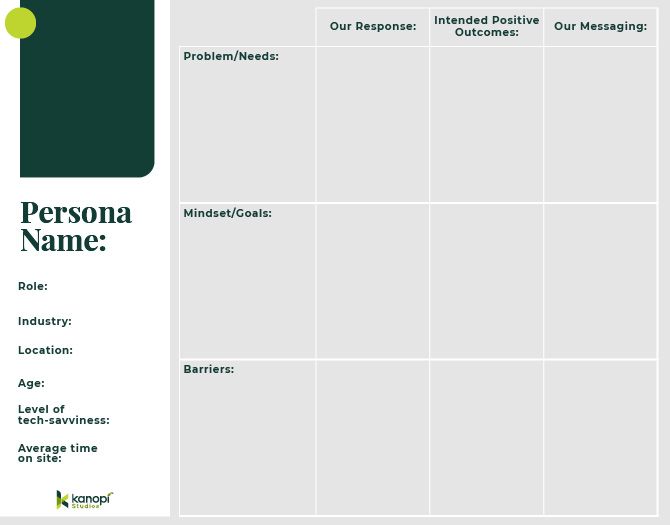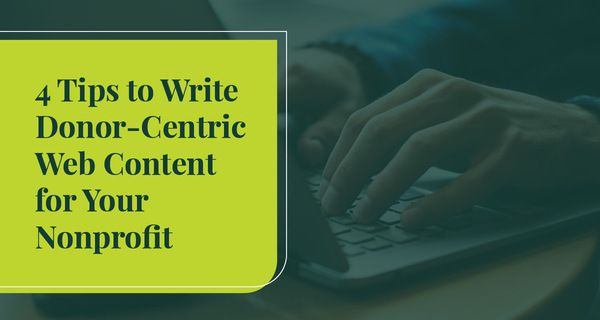Customer-centric companies are 60% more profitable than businesses that aren’t, and 68% of users will abandon a brand if they think it doesn’t care for them. That’s why user-centric marketing is essential across every sector.
As a nonprofit marketing professional, it's crucial to show supporters that you care about them as people and want to create positive online experiences for them. One of the most effective ways to do so is to create donor-centric web content.
Let’s review four tips for crafting donor-centric web content that builds strong supporter relationships:
- Create and leverage user personas.
- Show donors’ impact.
- Incorporate user-generated content.
- Let data guide your strategy.
According to Kanopi’s roundup of top nonprofit websites, “successful nonprofit marketing teams ask questions and explore how their donors behave on a regular basis to identify changing trends.” These tips will help ensure your website’s content is tailored to your unique audience and their preferences.
1. Create and leverage user personas.
A user persona is a fictional character that represents a segment of your nonprofit’s target web audience. You can develop personas by identifying common traits across your donor base and grouping individuals based on these characteristics.
For example, perhaps you’re creating donor personas for your healthcare nonprofit’s website. You may create personas for donors who are former patients, major donors, corporate partners, donors who also volunteer, and prospective donors.
Give each persona a unique name, defining characteristics, information about what they’re looking for from your website, accessibility needs, and details about the type of messaging that would be helpful to them.
Use this template to add detail to each persona:

You’ll probably end up with more than one overarching audience group—typically, developing three to five unique personas helps account for the unique segments within your community.
Personas can help you create better donor-centric web content in the following ways:
- Write tailored web content that’s relevant to each persona’s interests, needs, and goals.
- Improve your SEO strategy by creating content that’s more helpful for specific audiences.
- Choose compelling images that appeal to each persona.
- Use storytelling strategies that resonate with your target audience based on the types of content they’ve previously expressed interest in.
Continually update your personas as needed to ensure that your content stays relevant to your audience’s needs and motivations. To account for potential audience shifts, review your personas at least twice a year.
2. Show donors’ impact.
Typically, donors all have one question in common: what did their contributions actually do? Whether they contributed to your giving day campaign or supported a peer-to-peer fundraising event, donors want to know how your nonprofit used their gifts to further your mission.
Use your website to showcase donors’ continued positive impact on your cause. Demonstrate their impact in multiple ways, such as through:
- Infographics. Create graphs or charts that spotlight the impact of donors’ contributions to certain campaigns. For example, let donors know that their $80,000 in contributions to your giving day campaign allowed your nonprofit to renovate your animal shelter, growing capacity from 100 to 250 animals.
- Videos. Create an explainer video to demonstrate how donations helped push a recent campaign to success or share a timeline of how donors’ support has helped your nonprofit grow exponentially over the past five years.
- Community member testimonials. Use videos or blog interviews to spotlight community members’ stories and messages of gratitude for donors.
Find ways to personalize your impact-centered web content. For example, eCardWidget recommends creating a virtual donor wall with recognition tiers for different giving levels. Make sure to ask donors’ permission before recognizing them publicly on your website.
3. Incorporate user-generated content.
Donors will feel more engaged with your content when they have the opportunity to be featured in it. This is where user-generated content comes into play. User-generated content includes any content (images, written text, videos, etc.) created by your audience members, such as:
- Social media posts
- Images and videos
- Audio clips
- Donor testimonials
- Event recaps
- Artwork that’s relevant to your mission
Share this user-generated content on your website’s homepage and blog. For example, you can share a live social media feed on your homepage or include user-submitted images in a blog post recapping a recent event.
4. Let data guide your strategy.
We don’t recommend going with your gut or hunches when it comes to developing user-centric web content. Making subjective choices can lead to a misalignment between what your team thinks your audience wants and what they actually want. Instead, you should rely mostly on cold, hard facts.
A data-driven approach gives your team clear metrics to work toward and can improve your marketing content’s return on investment. Use the following resources to gather data about your website audience:
- Google Analytics
- Visitor behavior tools like HotJar
- Audience feedback surveys
Leverage these resources to gather data such as traffic sources, website bounce rates and average time on page, visitor satisfaction, visitor demographics, and other user-experience data. Use this information to further refine your personas, determine what types of content are most engaging for your audience, and make it easier for visitors to find your website.
Note how your metrics are performing before and after making content updates. This way, you can see which updates were most impactful for driving higher visitor engagement.
Consider working with a nonprofit web design professional to help further refine your audience personas and content strategy. These experts can help enhance your content strategy based on current best practices and your organization’s unique data insights.
With these tips, you should be able to create engaging, donor-centric content that drives traffic and increases support for your fundraising efforts.
Special thanks to Anne Stefanyk for the expert advice. As Founder and CEO of Kanopi Studios, Anne helps create clarity around project needs, and turns client conversations into actionable outcomes. She enjoys helping clients identify their problems, and then empowering the Kanopi team to execute great solutions.
Anne is an advocate for open source and co-organizes the Bay Area Drupal Camp. When she’s not contributing to the community or running her thoughtful web agency, she enjoys yoga, meditation, treehouses, dharma, cycling, paddle boarding, kayaking, and hanging with her nephew.
